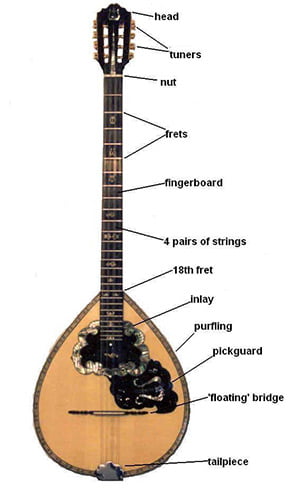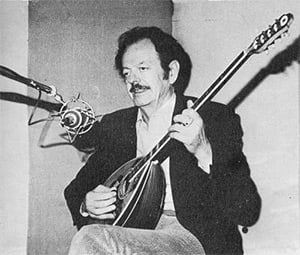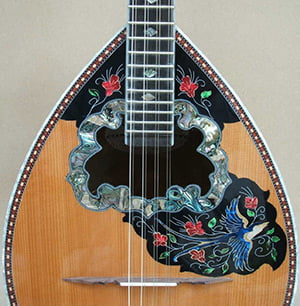The famous Greek bouzouki
The bouzouki is by far the most recognizable and distinctive Greek music instrument. Bouzouki is written as mpouzouki (μπουζούκι) in Greek, but the true sound of the word is closer to bouzouki than mpouzouki.
Bouzouki is a stringed instrument, which belongs to the family of the long-necked lutes. Instruments of a similar shape can be found in Pre-Hellenic civilizations (Egypt, Assyria, China, India). In ancient Greece, an instrument similar to bouzouki was known under the name “pandouris”, and from Byzantium onwards, it became known as the “tambouras”.
On display in the National Archaeological Museum of Greece is the tambouras of General Makriyiannis, hero of the 1821 Greek revolution. This tambouras bears the main morphological characteristics of the bouzouki used by the rebetes playing rebetika songs.
Greek Bouzouki
The bouzouki has a pear-shaped sound-box and a fretboard of about 60-70cm in length, populated with metallic frets. It has three double metallic strings (each pair tuned in unison). Its basic tuning is D-A-Doct. There are variations such as the G-A-D or A-E-Aoct., which is not currently used.
At some point in the 1960s, a fourth string was adopted into the bouzouki’s configuration. Regarding the intervals, the new D-A-F-C tuning became identical to the first four strings of the traditional guitar. The bouzouki is played with a plectrum (pena or pick), which, in older times, would have been made from a bird’s feather, a horn or the bark of a cherry tree. Greek bouzouki is different from the Irish bouzouki that looks like a mandolin.
Bouzouki History
 The history of bouzouki is actually intertwined with the rebetika songs, which is among the most distinctive Greek music sounds. The culture of rebetika songs started blooming in the hashish venues and prisons of the port towns in Asia Minor and the Aegean Sea islands at the early years of the 20th century, and reached its peak later during and between the main World Wars.
The history of bouzouki is actually intertwined with the rebetika songs, which is among the most distinctive Greek music sounds. The culture of rebetika songs started blooming in the hashish venues and prisons of the port towns in Asia Minor and the Aegean Sea islands at the early years of the 20th century, and reached its peak later during and between the main World Wars.
In the first years the assembly would include the singer, two players of bouzouki that played simple chords at first, and of course the baglama, which is a small version of the bouzouki. Its sound and rhythm is little different than bouzouki, being more of a staccato rhythm. At first, though, it was always accompanying the bouzouki.
These rebetika songs had lyrics about hookers and pimps, drugs, love, money, death and everything that could be associated with everyday life. The chords of the songs were based on a wide range of rhythms and ancient modes, and stood out due to the improvisation of their introductions known as taxims.
The bouzouki was reintroduced and brought to Greece by immigrants from Asia Minor and Turkey in the early 1900’s.
In the early part of the 20th century the “Rebetes” played the Bouzouki and the baglamas, later they added the guitar for chords. The baglamas is a smaller version of the bouzouki.
The baglamas is tuned (re,la,re) exactly like the (trichordo) bouzouki. The baglamas was an easy instrument to carry because of its small size. Today the baglamas is used to add color and to give a precise, distinct, vibrato sound to the composition.
Influential bouzouki players
Some of the most known early bouzouki players also called rebetes, were Ioannis Papaioannou and Márkos Vamvakáris.
 The somewhat harsh reputation of rebetika songs finally softened a few years later, allowing bouzouki to enter the mainstream Greek music. Greece had the chance to introduce its most important player, who was both a master player and a prolific composer of music, the famous Vasilis Tsitsanis.
The somewhat harsh reputation of rebetika songs finally softened a few years later, allowing bouzouki to enter the mainstream Greek music. Greece had the chance to introduce its most important player, who was both a master player and a prolific composer of music, the famous Vasilis Tsitsanis.
It was Tsitsanis the one who enhanced the known rhythms with a more elaborate and modern chord progression adding a a western sound and music sensibility, writing lyrics that touched the hearts of his audience more, having a greater appeal to the Greeks compared to the heavy and roughneck lyrics and tales created by former composers and lyric writers.
Tsitsanis made bouzouki more recognizable and more acceptable to the Greek society. Speaking on modern words we could say that he was the first star of the bouzouki in Greece. Later on, when he died in 1983, more than 200 thousand people went to his funerals, most of them holding baglamas and bouzoukis in the streets of the city.
There were, though, many bouzouki virtuosos who took over Tsitsanis’ legacy. One of them was Manolis Hiotis, who made a rather impressive addition to bouzouki: he added a 4th course of strings to the instrument, making a huge change to its sound and tuning to CFAD. This was a more modern arrangement that allowed bouzouki to produce a different, more appealing sound, giving the composers the chance to compose in a more flexible and diverse way as well.
The bouzouki has been persecuted by the authorities in the past century and part of this century as they had associated it to the criminal society of Greece, (unfairly and wrongly). It is purely a “sole” instrument and even though various qualified teachers have written many books, it may never be learned by just anyone.
By this statement we mean that even though everyone may have the ability with proper training, to make music with a bouzouki, few of us posses the ability to be able to perform with it and to relay through the instrument our most inner feelings, thoughts, and emotions, which change from moment to moment. In a nutshell it is the “mirror” of our soul.
A good bouzouki player must be able to produce clean notes at a higher speed than other stringed instruments. It takes years of studying and countless hours of constant practicing on a daily basis. Once a player commits to playing the instrument he may not be able to slack off and ignore daily practice time, as this will result in a decline in his dexterity and agility.
From the bouzouki with 3-strings to 4-strings
 The 3-chords (trichordo) bouzouki, has three pairs of strings, each pair tuned the same. It is tuned to “re”, “la”, “re”, (d,a,d,) The (re) string is the basis for the melody, while the A and second D strings are used for playing chords. The first bottom (D) string is known as “Kantini”. The sound of the top (D) string is known as “Bourgana”.
The 3-chords (trichordo) bouzouki, has three pairs of strings, each pair tuned the same. It is tuned to “re”, “la”, “re”, (d,a,d,) The (re) string is the basis for the melody, while the A and second D strings are used for playing chords. The first bottom (D) string is known as “Kantini”. The sound of the top (D) string is known as “Bourgana”.
In the olden days, the bouzouki was tuned to accompany the different modes (styles of songs) being played. This type of tuning is called “Ntouzeni” (Du-zeni), and is essential to preparation to playing.
The bouzouki is played with a pick, but in the past it was played with a feather or a piece of wood carved from a cherry tree. This helps to create the distinctive sound of bouzouki music.
In the 1950’s the bouzouki with four pairs of strings was introduced. The three strings limited the musician to playing the rebetika songs only. The four strings gave a new dimension to the capabilities of the instrument.
The new bouzouki that was developed in the fifties is named “tetrachordo” and has four pairs of strings that are tuned (c,f,a,d). The chords played on the bouzouki are the same as a guitar. A distinct characteristic of the bouzouki is the taxim.
Bouzouki and Bouzoukia in Greece
This music instrument has been combined with the history of the Balkan Peninsula, and particularly Greece, for many years and is part of its traditional music. The music and the clubs that play it, are referred to as bouzoukia (deriving from the plural of the word bouzouki – in Greek bouzoukia, μπουζούκια), after the primary instrument involved.
For sure, one would wonder how come the Greeks ended up calling the clubs that play a particular type of music with an instrument’s name. Accidental fact? Bouzoukia are the main entertainment for Greeks because they represent a need impressed in the lyrics of a famous laiko song: “mia zoi tin ehoume ki an den tin glentisoume…” meaning “We have only one life, so we have to celebrate it…”
This is how & why bouzoukia are born. From the need of Athenians to let themselves go, nibble, drink and dance while listening to their favorite music live from their favorite artists.
This is how the most famous and distinctive Greek music instrument actually gave its name to the most common and popular way of going out at night to have fun with friends.
However, since Greeks tend to combine music with all aspects of their life, you can hear people going to bouzoukia to forget – even temporarily- the loss of a big love, a divorce, anything related to love and personal feelings.